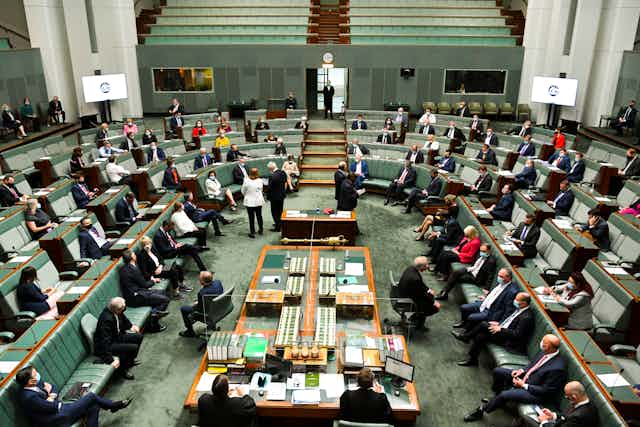The Australian Electoral Commission has updated its database of financial disclosure information for 2020-21.
This happens once a year and is keenly watched by political observers because it includes information about who is donating what to whom.
And yet, despite Australia’s political parties collectively reporting A$177 million in income, only a tiny fraction of this is identifiable. So the public is left with a woefully inadequate picture of what is actually going on with political funding in Australia.
What does the data tell us?
State elections attracted the big bucks
Queensland, Western Australia, Tasmania, the Australian Capital Territory and Northern Territory all went to the polls last year. So it is perhaps no surprise that most of the donations in Tuesday’s data release were made to political party branches in these states.

The Queensland election in particular attracted some very large donations, including almost $4 million from entities directly associated with the Labor Party. These associated entities are controlled by the party and their income is opaque, but usually includes money from fundraising functions and investments.
Typically, the party in power receives slightly more income than the opposition, but donations last year were particularly skewed towards the incumbents – at both state and federal levels.
Who are the major donors?
The biggest donor for the Coalition was Pratt Holdings, with more than $1.2 million in donations to the Liberal Party.
Other significant donations to the Coalition were received from fundraising vehicles and investment bodies (for example, the National Policy Forum and Cormack Foundation). Liberal candidate Scott Edwardes also made a large donation ($224,000), presumably to support his own (ultimately unsuccessful) campaign in the WA election.
Labor’s biggest support came from its associated entities and several unions, including the Shop, Distributive and Allied Employees’ Association, United Workers Union, and the Construction, Forestry, Maritime, Mining and Energy Union.

Some companies such as ANZ bank and Wesfarmers regularly contribute more than $100,000 to both major parties and did so again this year. Village Roadshow cinemas is also a regular donor in election years. Indeed, despite cinemas suffering substantial losses during the pandemic, Village managed to stump up $25,000 for both sides in the Queensland state election.
Donations open powerful doors. Australia’s political parties typically rely on just a handful of major donors, and these donors can achieve significant access and influence. In 2020-21, the top five donors represented 39% of the Coalition’s declared donations and 57% of Labor’s.
Beyond the political parties, two major grassroots political movements declared substantial funding: the right-wing movement Advance Australia raised $1.3 million, mainly from companies with no public presence, and left-wing movement GetUp! raised $553,000, all from individuals.
War chests
Political donations help parties campaign and spread their message at election time. Four of the past five federal elections have been won by the major party with the bigger war chest.
Read more: How big money influenced the 2019 federal election – and what we can do to fix the system
The Coalition was the big winner in 2020-21 with 23% more income than Labor, despite declaring fewer donations. The Coalition has raised more in both financial years since the last federal election, with about 20% more than Labor in 2019-20 too.
Is this the full picture?
The two major parties declared income totalling more than $150 million to the AEC in 2020-21. But the data released on Tuesday shows declared donations make up just 9% of this.
Most political party income is undeclared or falls into a messy bucket called “other receipts”. This includes money contributed by individuals and corporates at fundraising functions - money clearly intended to support the party and buy access. Parties declare their “other receipts” but it is impossible for the public to distinguish between money raised at fundraising events and income associated with party investments or services.

Another major problem is donations received below the threshold of $14,300 do not need to be declared by the party. This enables large donors to split their donations into several below-threshold payments to avoid scrutiny.
Together, these loopholes mean major donors can hide, and Australian voters cannot be sure who is really backing our political parties.
Election to shine spotlight on integrity
Australia’s major parties will be scrambling right now to bring in funds for this year’s federal election campaign.
Yet this 2020-21 data release does not tell us who is donating now in the lead up to the federal election. Nor who is likely to get priority access to the next government. Unless the rules are changed, voters won’t know the answers to these questions until it’s too late.
Read more: More than half of funding for the major parties remains secret — and this is how they want it
Despite consistent calls for donations reform from many minor parties and independents over more than a decade, the major parties continue to resist greater transparency.
The federal Coalition has a terrible track record on transparency. Meanwhile, Labor may have proposed lowering the donations disclosure threshold, but it has failed to put any pressure on the government to close loopholes and make the data more timely.
However, there is some hope for reform. Many independents and minor parties will be campaigning on integrity issues in the 2022 election, and this could force pre-election commitments from the major parties. If crossbenchers end up with the balance of power after the election, they are likely to demand much greater transparency from the next government.

